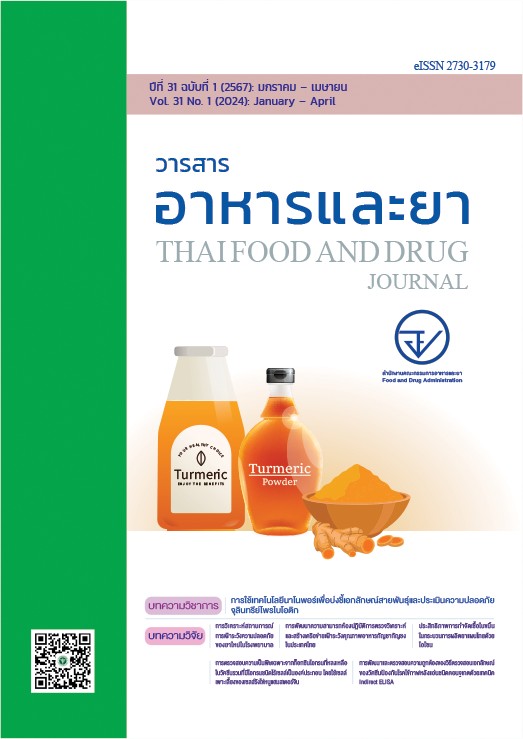การวิเคราะห์สถานการณ์การเฝ้าระวังความปลอดภัยของยาใหม่ในโรงพยาบาล
Main Article Content
บทคัดย่อ
ความสำคัญ :สืบเนื่องจากประกาศของสำนักงานคณะกรรมการอาหารและยาเรื่อง แนวทางติดตามความปลอดภัยของยาใหม่ตามระดับความเสี่ยง พ.ศ. 2560 ซึ่งกำหนดให้มีแนวทางการติดตามความปลอดภัยที่แตกต่างกันตามระดับความเสี่ยงของยา พบว่า ยังไม่มีแนวทางปฏิบัติด้านความร่วมมือระหว่างโรงพยาบาลและผู้ประกอบการเกี่ยวกับยาใหม่ภายใต้โปรแกรมติดตามความปลอดภัย (Safety Monitoring Program; SMP) วัตถุประสงค์: เพื่อศึกษาสถานการณ์การติดตามข้อมูลความปลอดภัยของยาใหม่ตามลักษณะความเสี่ยงระดับต่าง ๆ ในโรงพยาบาล และศึกษาการมีส่วนร่วมของผู้ประกอบการในการติดตามความปลอดภัยของยาเหล่านี้ในโรงพยาบาล
วิธีวิจัย: เป็นการวิจัยเชิงคุณภาพ คัดเลือกโรงพยาบาลรัฐบาลในเขตกรุงเทพและปริมณฑลที่มีขนาดไม่น้อยกว่า 400 เตียงที่มีการใช้ยาใหม่ภายใต้เงื่อนไข SMP ในบัญชีรายการยาของโรงพยาบาลในช่วง 2 ปีที่ผ่านมา จากนั้นสุ่มตัวอย่างโรงพยาบาลแบบเฉพาะเจาะจง (purposive sampling) เก็บข้อมูลระหว่างวันที่ 1-31 สิงหาคม 2565 ด้วยการสัมภาษณ์เชิงลึกโดยใช้แบบสอบถามคำถามกึ่งโครงสร้าง สัมภาษณ์เภสัชกรตัวแทนโรงพยาบาลในพื้นที่กรุงเทพและปริมณฑล ทั้งหมดไม่น้อยกว่า 6 แห่ง หรือจนกว่าข้อมูลจะอิ่มตัว
ผลการวิจัย: จากโรงพยาบาลที่เข้าร่วมการศึกษา 6 แห่ง พบว่ากระบวนการรายงานเหตุการณ์ไม่พึงประสงค์ของทุกโรงพยาบาลมีความคล้ายคลึงกัน คือ เภสัชกรจะเป็นผู้ประเมินความสัมพันธ์เชิงสาเหตุที่ครอบคลุมถึงยาใหม่และยาที่ถูกปลด SMP และบันทึกข้อมูลลงในฐานข้อมูลของโรงพยาบาล แล้วรายงานไปยังศูนย์เฝ้าระวังความปลอดภัยด้านผลิตภัณฑ์สุขภาพ (Health Product Vigilance Center, HPVC) โดยมี 1 โรงพยาบาลส่งเฉพาะเหตุการณ์ไม่พึงประสงค์ระดับร้ายแรงเท่านั้น เนื่องจากภาระงานที่มาก เมื่อสอบถามถึงความเป็นไปได้ของผู้ประกอบการในการมีส่วนร่วมติดตามความปลอดภัยของยาใหม่ร่วมกับโรงพยาบาลพบว่า ส่วนใหญ่เห็นว่ามีความเป็นไปได้แต่ไม่สามารถให้การสนับสนุนได้เนื่องจากข้อกังวลเกี่ยวกับพระราชบัญญัติคุ้มครองข้อมูลส่วนบุคคล และการทำงานร่วมกันจะต้องได้รับอนุญาตจากผู้อำนวยการโรงพยาบาลหรือคณะกรรมการโรงพยาบาล นอกจากนี้เพื่ออำนวยความสะดวกให้โรงพยาบาล ควรกำหนดให้มีการแจ้งสถานะของ SMP เมื่อยาได้รับการคัดเลือกเข้าโรงพยาบาล และเมื่อยาถูกปลด SMP รวมถึงควรสรุปข้อมูลความปลอดภัยที่สำคัญของยาใหม่ SMP และให้ข้อมูลแก่ผู้มีส่วนได้ส่วนเสียที่เกี่ยวข้องในโรงพยาบาล
สรุปผล: หลักการของการติดตามความปลอดภัยของยาใหม่แบบมีเงื่อนไขของโรงพยาบาลมีความคล้ายคลึงกันแต่อาจแตกต่างกันในการปฏิบัติ สิ่งที่โรงพยาบาลต้องการจากผู้ประกอบการคือการสนับสนุนข้อมูลความปลอดภัยที่สำคัญของยา และข้อมูลใหม่ต่าง ๆ ของยาเมื่อมีการเปลี่ยนแปลง
Article Details

อนุญาตภายใต้เงื่อนไข Creative Commons Attribution 4.0 International License.
เอกสารอ้างอิง
วิมล สุวรรณเกษาวงษ์, พัทรียา โภคะกุล. การพัฒนาหลักเกณฑ์การติดตามความปลอดภัยผลิตภัณฑ์ยาใหม่ตามลักษณะความเสี่ยงในประเทศไทย. วารสารอาหารและยา 2562;26(3):11-24.
ประกาศสำนักคณะกรรมการอาหารและยา เรื่อง หลักเกณฑ์การติดตามความปลอดภัยผลิตภัณฑ์ยาตามลักษณะความเสี่ยง (Risk-Based Approach Safety Monitoring Program). (ลงวันที่ 9 ตุลาคม 2560).
ประกาศสำนักงานคณะกรรมการอาหารและยา เรื่อง แนวทางสำหรับผู้รับอนุญาตในการรายงานความปลอดภัย ของยาที่ใช้ในมนุษย์ยาเสพติดและวัตถุที่ออกฤทธิ์ต่อจิตและประสาทที่ใช้ทางการแพทย์ภายหลังออกสู่ตลาด (ลงวันที่ 18 ธันวาคม 2558).
ศูนย์ติดตามอาการอันไม่พึงประสงค์จากการใช้ผลิตภัณฑ์สุขภาพ สำนักงานคณะกรรมการอาหารและยา. สำนักคณะกรรมการอาหารและยา. แนวทางปฏิบัติงานการติดตามอาการอันไม่พึงประสงค์จากการใช้ยา. นนทบุรี; 2543.
N. Jarernsiripornkul, J. Krska, M. Pongmanachai, et al. Hospital pharmacists’ activities and attitudes regarding the Thai safety monitoring program for new drugs. Pharmacoepidemiology and drug safety 2009; 18: 837–841. DOI: 10.1002/pds.1790.
ศูนย์เฝ้าระวังความปลอดภัยด้านผลิตภัณฑ์สุขภาพ. แบบรายงานเหตุการณ์ไม่พึงประสงค์จากการใช้ผลิตภัณฑ์สุขภาพ (HPVC Form-1) (one page). [อินเทอร์เน็ต]. [เข้าถึงเมื่อ 10 ก.ย. 2565]. เข้าถึงได้จาก: https://hpvcth.fda.moph.go.th/form_dowload/
ศูนย์เฝ้าระวังความปลอดภัยด้านผลิตภัณฑ์สุขภาพ. แบบรายงานเหตุการณ์ไม่พึงประสงค์จากการใช้ผลิตภัณฑ์สุขภาพ (HPVC Form-1) (New). [อินเทอร์เน็ต]. [เข้าถึงเมื่อ 10 ก.ย. 2565]. เข้าถึงได้จาก: https://hpvcth.fda.moph.go.th/hpvc-form-1-แบบรายงานเหตุการณ์ไม-8/


